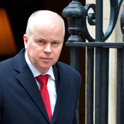While waiting for the exit polls in Sweden’s nail-biting election earlier this month, I was stood in the middle of the Social Democrats’ election party in the city of Malmö, flanked by members of parliament as well as elder statesmen of the trade union movement.
Malmö is a red city. In the cavernous lobby of the trade union hall—where the party was being held—there was a huge 12-foot-high banner of the current prime minister, Magdalena Andersson, hanging from the balcony, offset by murals harking back to a time when the Social Democrats were an all-conquering force in Swedish politics.
A cheer went up as the exit polls finally dropped: it looked as though Andersson had fought back the populist opposition and engineered an unlikely victory. Just an hour later however, as numbers began to filter through from polling stations, you could hear a pin drop. By the end of the night the right bloc had gained a narrow lead of just one seat. Even after persuading the small liberal Centre party to join them as potential coalition partners, the Social Democrats still found themselves kicked out of power and wondering what comes next. Sweden has eight parties, from the socialist left to the far right, split into two blocs that generally fall in line behind the traditional big hitters of the Social Democrats and the Moderate party. As the week crept on it became clear that the right and far right alliance of parties had mustered the crucial 175 votes to unseat the already weak Social Democrats.
This was the narrowest of defeats for Sweden’s progressives and the narrowest of victories for its new right cluster, of which two-fifths is composed of the Sweden Democrats alone, making it the largest party in the bloc. Strongly anti-Islamic, with a hardline stance on crime and migration, several members of the party’s current leadership joined when it still had explicit links to Nazism. Ideologically it sits alongside groups such as Marine Le Pen’s National Rally and describes itself as "national conservative.” The right victory came off the back of a campaign that has been underhand, confused, chaotic and unedifying for all. With the media dominated by stories about inflation, an energy crisis and spikes in violent crime across Sweden’s cities, voters went to the polls with a distinct sense of ambivalence. To them the political landscape looked devoid of a cohesive vision for the country’s future.
Many swing voters were unsure what to believe. Despite her personal popularity, Andersson was painted by her opponents as the leader of a coalition of chaos with the Left and Green parties. Indeed the Greens, a minor force in Swedish politics, were portrayed as the cause of the country’s high energy prices, while the Left seen as a rogue’s gallery of communists, radical feminists and fifth columnists. Left party leader Nooshi Dadgostar became the perfect target for Sweden’s insurgent nationalist keyboard warriors: she was born to Iranian parents living in a home for asylum seekers.
This was always going to be a difficult election for Andersson—who from her first day in office in 2021 governed with a fragile minority administration—but the continued growth of the far-right Sweden Democrats and their normalisation by Swedish liberal conservatives has moved the goalposts considerably. As the right bloc as a whole adopted the Sweden Democrat’s usual attack lines around energy, crime and cultural integration, they closed ranks and gave voters a binary choice between “more Andersson” and what was euphemistically referred to as “Ulf Kristersson’s side” (the leader of the Moderate party). Amid this choice, the chance for consensus across the centre in Sweden’s usually civil politics disappeared.
It has been 20 years since the Social Democrats last delivered a convincing election victory under the leadership of former prime minister Göran Persson. Unionised labour has not been loyal to its old party, and it is in the country’s former industrial towns that the far right has made its biggest inroads in recent years. The fact that Andersson’s party—once the global flag bearers for social democratic politics and social change—would have regarded a centrist alliance as a victory in this election speaks volumes about its reduced ambitions.
Even more worryingly for the left is polling data that revealed young people had flocked to both the conservatives and the Sweden Democrats in Sunday’s poll: 22 per cent of first-time voters chose the Sweden Democrats, according to data by public broadcaster SVT, with 26 per cent choosing the Moderates. On election night in Malmö, retired union men with moustaches, pensioners and party staff were more numerous than the young activists. The party and the social movement that supports it—what Swedes refer to as the folkrörelse—is evidently in poor health.
Internally there have been some heated debates, similar to those among Labour members in the UK and the Democrats in the US, about whether to assuage centrist voters or to focus on inequality and bread-and-butter left politics. Andersson had to fight the election on issues of the right bloc’s choosing, with her party going so far as to test the waters on hardline policies, including quotas for “non-Nordic” migrants in housing and tougher prison sentencing. At no point was there a strong sense of what a renewed movement for social democracy would look like as an alternative.
You need only look across the water from Malmö to Copenhagen to see what left politics stripped of its utopian and humanitarian vision looks like. Denmark’s governing Social Democrats have been eager to embrace hardline immigration policies in recent years; the “Danish model” is suddenly on the lips of many Swedish politicians. Both the Moderates and their coalition partners have been enthusiastic about Denmark’s hostile environment for asylum seekers and its enthusiasm for offshore processing.
What now for Sweden? The fragile right government that appears set to take over the reins will inherit a situation of its own making. It has painted a picture of a country with innumerable problems and at the mercy of criminal gangs and social decay. In the coming months, it will have to be seen to provide answers to those problems. It could yet collapse amid infighting—but equally it could shift Swedish politics further from the centre left, with no obvious way back. For the Social Democrats, the problem is larger still. The party that defined Sweden and Swedish politics internationally for a century is stuck. Swedish social democracy always found its relevance and appeal as a solution to tangible problems, underpinned by the sense that Sweden itself was a blueprint for a better future. If the party loses that vision, then it has little to offer voters and the wider world beyond managerialism and moderation.












